Shared Space
When three UW alumnae get to work each day, it’s all about astronauts and space suits and an evolving partnership with Russia to explore the universe. How cool is that?
Karina Eversley ’96 took seven semesters of Russian at UW–Madison, in part because she was intrigued by how the language and its alphabet differed from English. But she had another, particularly compelling reason for cramming these courses into her schedule as she pursued an engineering mechanics degree.
For as long as Eversley could remember, NASA was the only place she’d ever wanted to work.
She reached her goal before she graduated, thanks to a program that gives engineering students the chance to live that dream for a summer or a semester. That opportunity led Eversley, today a spacewalk flight controller and instructor, and a number of other alumni to the National Aeronautics and Space Administration’s Johnson Space Center in Houston, Texas, where seeking the next giant leap for mankind is resolutely regarded as just part of the job.
And today, as the space program changes and charts a new course, Badgers are playing key roles in NASA’s future.
The Cold War was over when Eversley graduated from the UW, and international cooperation was replacing the space race with the Soviets, something she’d bet on when she studied Russian.
Eversley had her inaugural experience in Mission Control during the first International Space Station (ISS) assembly flight in 1998. It was an intense time. After all the procedures were written and the finest of details worked out, Eversley recalls, “It was halfway through the flight before I sat there in Mission Control and thought, ‘Whoa, this is real … It’s actually happening.’ ”
She then put her language training into daily practice, living in Russia for months at a time for more than two years while she trained and prepared the station’s early crews.
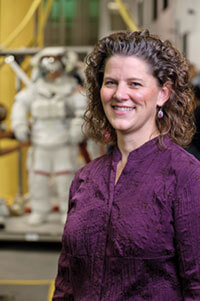
Karina Eversley first dreamed of working for NASA while in middle school, then made it happen by competing successfully in a program that places engineering college students at space centers. She also learned Russian, knowing that the United States and Russia were evolving from rivals to partners in space exploration.
Catching the Space Bug
Eversley set her sights on the space program after watching The Right Stuff in middle school. “I saw that movie, and I [thought], ‘Oh my god, I want to work for NASA,’ ” she recalls.
When Eversley arrived at the UW from Middleton, Wisconsin, to earn a degree, she learned about “co-op programs” in the College of Engineering — cooperative education opportunities that make it possible for students to gain real-world engineering experience while completing their degrees. As soon as she was eligible, she applied for all the programs offered at NASA’s space centers, hoping she’d get a job at one of them someday.
Johnson Space Center’s co-op students typically came from Purdue and nearby Texas A&M, but Eversley wanted to change that, getting her Badger foot in the door at the home of the manned space program. She was active in the UW’s Society of Women Engineers (SWE), and when a guest speaker turned out to be a former NASA engineer who had worked in Houston, she cornered him and asked, “Okay, how do you get in?” Armed with his advice, she succeeded in winning a slot.
“[During] my entire co-op, I was the only Badger,” Eversley says.
While a student, she also completed two co-op tours at Glenn Research Center in Cleveland, Ohio. During one, she watched on NASA closed-circuit TV as the heads of the U.S. and Russian space programs signed an agreement to fly the Space Shuttle to the Russian Mir space station — making it possible for American astronauts to live on Mir.
“Of course, I was pretty psyched,” she says.
It wouldn’t be long before another Badger came on board. Nikki Williams ’00 heard Eversley speak about her experiences in Houston during another SWE meeting and decided, “Oh, that’s it. That’s what I want to do.”
With Eversley’s help, Williams landed a summer position at the Marshall Space Flight Center in Huntsville, Alabama, and then spent the fall semester working at Johnson Space Center, where she returned for four more tours while in college. During her senior year, she joined the College of Engineering’s zero-gravity team, flying an experiment on NASA’s “vomit comet,” a fixed-wing aircraft that briefly creates the sensation of weightlessness by following an elliptic flight path.
A few years later, Angie Lenius ’06 joined NASA.
Lenius grew up watching Star Trek with her dad and sitting on the back porch of her home in Omro, Wisconsin, searching the night sky for constellations pictured in her astronomy guide.
“For as long as I can remember, I wanted to be an astronaut — [I] wanted to work for NASA,” she says. “I’ve always loved space.”
Stargazing materialized into a career path during her sophomore year at the UW, when NASA conducted on-campus interviews for its co-op program. Lenius, now a lead systems engineer in Houston, says advice and guidance from Eversley made the difference. “I emailed her,” Lenius says, “asking, ‘What do I need to do? What do I need to know?’ ”Eversley says she can’t take credit for every UW graduate who works at Johnson Space Center “because it’s been a domino effect. But I feel like I opened the door.”
Twisting a Balloon
Space walks depicted in movies or on television give the impression that astronauts can just float around and enjoy the view. But preparing for space walks is a lengthy and highly choreographed effort.
During one such training session, an astronaut is standing on the deck of a larger-than-Olympic-size pool filled with 6 million gallons of water. She’s dressed in a white suit designed to provide ventilation and cooling via water pumped through tubes near her skin. It takes a small team to help her into the next layer — a space suit, along with weights strapped around her legs and chest to keep her at the bottom of the forty-foot-deep pool. That’s where a mock-up of the International Space Station rests, looking a bit like a ghost of the real thing.
NASA astronauts spend up to seven hours underwater in this Neutral Buoyancy Laboratory for every hour that they’ll spend on a space walk.
The first space suits were based on the high-altitude suits worn by military test pilots, but they weren’t designed to be worn outside a space capsule. The current model, which has been used for three decades, looks like a squishy marshmallow, yet weighs about three hundred pounds. Add in the astronaut’s weight and the tools needed for a typical walk, and the suit now weighs approximately seven hundred and fifty pounds. Its built-in joints and bends, including customized gloves, make it easier to get around, but any movement still feels like trying to twist a blown-up balloon. Wearing it and working in it take practice.
While astronauts are in the water, Eversley’s job is to talk them through the difficult dance of a space walk, helping them to learn and master the tasks they must accomplish in space. At other times, she works with a different crew on Earth to test out a spacewalk, and then sends instructions to astronauts in the space station when they need to make repairs.
After being lowered into the water, aided by a pair of scuba divers, the astronaut maneuvers at the bottom of the pool as another trainer walks her through the task at hand. Via a headset in the helmet, the trainer suggests a new maneuver to try — such as using a hook or a tether — if the astronaut can’t reach or see something.
Eversley says the sessions help trainers develop the best way to approach tasks during future space walks. “It’s a two-way street,” she says. “We have to get a lot of information back from the crew.”
Although Eversley is not an astronaut herself, she has worn the suit, taken some of the same classes as the crews she trains, and strapped on scuba gear to dive into the training pool to get a closer look. “It’s kind of more of an art than science,” she says. “Three different crews could do three different space walks, but achieve the same result.”
Building the ISS, which has more square footage than a five-bedroom house, took 155 space walks. U.S. astronauts and their counterparts from other countries have continuously manned the station since November 2000.
Eversley will lead a space walk scheduled for later this year during which —as a barter system of sorts — U.S. astronauts will run power cables from their part of the station to a new Russian module.
Under Pressure
The atmospheric pressure on Earth is about 14.7 pounds per square inch. In space, it’s zero. Space suits are pressurized at a very low level — 4 pounds per square inch — so astronauts can move around to complete their assignments. Being inside the suit is similar to the conditions when climbing Mt. Everest; to avoid decompression sickness (also known as the bends), crew members need very pure oxygen to keep nitrogen from building up in their blood. The night before a space walk, astronauts sleep in the space station’s airlock module, where the oxygen has been cranked up to high levels and the atmospheric pressure is decreased to lower the amount of nitrogen in their blood. People get the bends when nitrogen bubbles form in the bloodstream from a rapid drop in pressure.
Before the shuttle program ended, NASA topped off the ISS’s high-purity oxygen tanks, but that supply will eventually be used up. Lenius is part of a team now working on an alternative solution, a pressure-swing absorption system that pulls oxygen from the atmosphere, pressurizes it, and stores it in large tanks outside the station. The idea was conceived by John Graf ’85, MS’87, a UW engineering graduate who works in Lenius’s group at NASA.
The process, Lenius says, is the same used for portable oxygen for emphysema patients. “It takes oxygen out of the ambient atmosphere and purifies it for them to breathe,” she explains, while standing inside a full-size mock-up of the space station’s airlock chamber. “The difference is that medical oxygen only needs to be something like 93 to 95 percent [pure]. For space, we need it to be 99.5 or more pure.”
And it must all fit “here,” says Lenius, pointing overhead to the ceiling of the airlock. “That’s exactly the problem that we’re getting into right now.” At that moment, the pieces of the system are spread out on a large rectangular table, called a breadboard, inside a concept-development laboratory run by two contractors just down the road from Johnson Space Center.
As a systems engineer for NASA, Lenius serves as the go-between for the ISS program and contractors Lockheed Martin and Wyle, making sure the device does what it is supposed to do and meets all requirements for readiness.
“We do have a leak on both sides. We need to fix that,” a team member tells Lenius, who is standing near a maze of wires, tubes, and circuits — and a pair of fuzzy white dice hanging overhead. The system is hooked up to old flight instruments to gauge oxygen levels. “It’s a multistage system, and, so far, only [the] first stage is operational,” she explains.
And scale matters. Ultimately, the entire system must fit inside three box-size units that measure twelve cubic feet and will be mounted on the airlock’s ceiling.
“This is the size it has to be,” Lenius says.
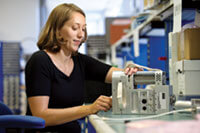
Angie Lenius loved searching the night sky for constellations as a child. As a UW sophomore, she reached out to fellow Badger Karina Eversley for advice about getting her foot in the door at NASA. Today she is a lead systems engineer at Johnson Space Center.
Better than Chicken Soup
Lack of gravity and oxygen are just two of the challenges in space. Living and working up there involve a lot of practical and personal matters that those of us back on Earth take for granted. Williams is a member of the flight crew equipment team, the group that tackles everything astronauts need in space, from toothbrushes to rehydrated food.
And then there’s trash. While the rest of us can take it out to the garage or send it down a garbage chute, those destinations don’t exist in space — and something must be done to control the smell, too. Unlike the shuttle, NASA’s new spacecraft in development, Orion, doesn’t have a venting system to control trash smells.
“It’s a gross problem, but it’s a very real problem,” Williams says.
Everything that goes into space must be certified for flight to ensure that it’s not flammable or toxic. Although NASA can buy things off the shelf, items must be vigorously tested before they are cleared for liftoff.
“I got a very good technical foundation at UW–Madison,” Williams says. “I was well-prepared to learn how to do whatever it was I need to do — build my thermal models, or work on my tests.”
To measure how effectively a trash bag already certified for flight would keep odors from taking over the entire vehicle, Williams and her team filled the bag with diapers, food trash, and vomit bags filled with simulated vomit. “In the past when we’ve certified vomit bags, we’ve used things like chicken soup,” she says. “I said, ‘Oh, we can do better than chicken soup.’ ”
The group mixed up a batch of fake vomit using a recipe found in some medical literature to generate the right odor and texture: apple juice, cottage cheese, frozen vegetables, soy sauce, tomato soup, and a few drops of some potent chemicals. “I was a very nauseous pregnant woman during that project, so I consider myself very knowledgeable on the topic,” she says with a laugh.
The other experts were an odor panel of volunteers at Johnson Space Center’s White Sands Test Facility in New Mexico. The filled trash bag was placed in a temperature- and humidity-controlled chamber, and the panel “sampled” the gas four times during a two-week period to see how well the bag contained the odor.
“It smelled — I’m not going to say it didn’t smell — but it was not hazardous,” Williams says.
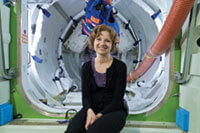
As a member of the flight crew equipment team, Nikki Williams worked on what astronauts need, from toothbrushes to meals to trash that isn’t too stinky. These days, she’s part of the team that is building the next-generation space suit. “A space suit is its own little vehicle,” she explains.
The Next Generation
Since May, Williams has been working on building the next-generation space suit, along with others assigned to a spacesuit-and-crew-survival branch. She is responsible for three of the branch’s five teams, making sure they have the tools, training, and equipment they need.
“A space suit is its own little vehicle,” she says.
Early in her career, Williams, who hails from Ashland, Wisconsin, was on her first-ever overseas trip, attending a meeting in Japan related to her thermal-analysis work. “I remember walking into the hotel we were staying at in Tokyo and realizing, ‘This hotel holds more people than my hometown,’ ” she recalls.
That sense of wonder truly takes hold during a visit to Johnson Space Center, where history fills every corner. Hallways are lined with portraits of astronauts, confidently smiling as they pose in flight gear, and displays of space suits from every era bear the names of brave men who are forever etched in the collective American memory. Then there’s the original Mission Control, now a historic landmark, where engineers in shirtsleeves and horn-rimmed glasses armed with slide rules guided missions to the moon. Turn a corner, and you’ll encounter a living, breathing astronaut, Shannon Lucid, who lived in space for six months on board the Mir space station.
It’s heady stuff that leaves visitors slack-jawed and struggling for words beyond cool and neat.
The same emotion prevailed on a day in Madison last spring, when an auditorium of middle school and high school students listened intently to Eversley, Lenius, and Williams, who were visiting campus for Engineering Expo. The women spoke about their jobs, the history of space travel, and NASA’s role in bringing innovations to the public. At the end of the presentation, several girls in the audience rushed to the front to get a closer look at a space suit display.
“They were just so excited and wanted to know everything … [asking] are they doing the right thing? What do they need to do for this or that?” Lenius recalls. “It’s just fun being able to inspire people the way that I have been inspired by others.”
The space shuttle took its final flight last year, and American astronauts must now hitch a ride on Russia’s Soyuz spacecraft to and from the space station. But there is a glimpse of the future inside Johnson Space Center’s Building 9, a massive facility with high ceilings where astronauts first trained for walking on the moon. Alongside realistic mock-ups of the shuttle and sections of the space station is one of Orion, the new deep-space capsule. NASA aims to launch it for an unmanned test flight in 2014 and send astronauts to explore an asteroid by 2025.
“We’re not going to be able to live on Earth forever,” Lenius told the students during her visit to Madison. “The next new world is somewhere out there.”
Jenny Price ’96, senior writer for On Wisconsin, admits that getting dizzy at IMAX movies does not bode well for becoming an astronaut someday.
Published in the Spring 2012 issue
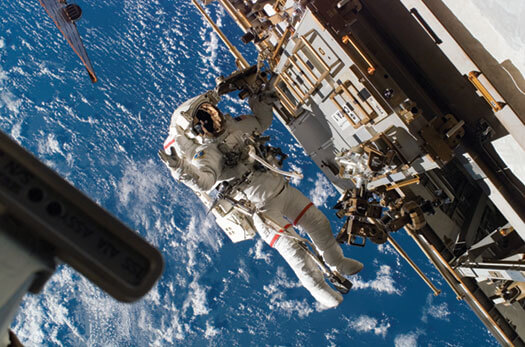
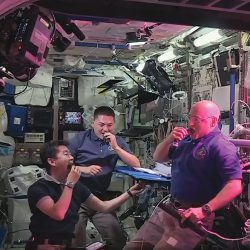
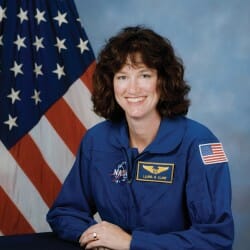
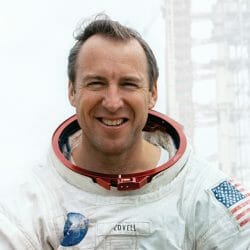
Comments
Dave Black April 11, 2012
Geoff Wawrzyniak (native of Franklin, WI) BS ’99 worked on the Mars Rover Project http://www.youtube.com/watch?v=gZ5kt_Kj6z8 with NASA
Janice M Bogstad March 25, 2013
This article has been very useful to me – I’ve referenced it at a STEM in Education conference in Beijing China in Nov. of 2012, two articles on women at NASA and at ISS for The International Encyclopedia of Women (online and in print) and am about to deliver a campus lecture on women in the current U.S. space program at your campus March 25, 2012.
Thanks for keeping me up to date on my alama mater
Dr. Janice M. Bogstad, classes of 1972 (BA), 1975(MA#1), 1987 (MA#2), 1992(Ph.D.)
Professor, Head of Technical Services, McIntyre Library
U of WIsconsin-Eau Claire
Janice M Bogstad March 25, 2013
whoops, that is March 25, 2013 – 6-7:30 pm